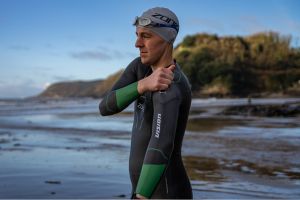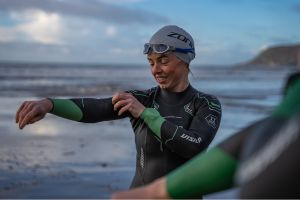1st Male – Tim Don – 9:32:42
1st Female – Flora Colledge – 11:27:27 (7th overall)
December 1st, 2019 saw the 2nd annual running of Patagonman, the final event on the XTri world tour for the year. The XTri circuit sees athletes racing long-distance triathlons in uniquely spectacular and testing locations around the world. This event is set in the heart of the Andes mountain range in Patagonia/Chile, taking in icy fjords, rugged mountains and lush forests. The race is contested over a 3.8km swim, 180km bike and 42.2km run and is billed as a triathlon “not for rookies”. The event is more of a journey than a race and is both extremely tough and exceptionally beautiful.
This was to be Tim Don’s first venture into Xtreme Triathlon, having seen the footage from last year’s event. “I thought “Bloody hell, I’ve never done anything like this!” It also fit in nicely with my season as I was doing Challenge Cape Town late in the season. The more I talked to people about XTri, such as Fraser Cartmell who had previously raced Celtman, the more I wanted to get involved. I knew there would only be 220 people in the race, out of 3000 people who applied for places. I also knew I could be competitive, and my result has now opened the door for a potential race at Norseman next year.”

Flora Colledge, 2nd place finisher at Norseman 2019 told us “I saw the footage from last year and immediately knew I had to go and race this event.“ As a seasoned XTri athlete she is used to enduring the hardships that the terrain and weather can throw her way during an event, but Patagonman was set to provide some different challenges than usual. The swim starts with a dive from the back of a ferry into the icy waters of the Aysén Fjord, before a 3.8km swim to the shores of Puerto Chacabuco. Water temperatures during practice swims in the fjord were well below 10°C, so athletes would have to be mentally prepared for a freezing experience.
Flora and Tim both decided to make full use of the Zone3 neoprene accessories range, wearing longsleeve neoprene baselayers, heat-tech gloves, heat-tech boots and neoprene caps! Flora told us “With the neoprene baselayer and accessories alongside the Vanquish wetsuit you get a really great combination of high performance and warmth. The Vanquish wetsuit gives amazing flexibility and buoyancy, while the baselayer adds a layer of comfort and warmth. There were Zone3 gloves everywhere you looked on the ferry!”. Luckily by race day the water had warmed slightly, with the fjord reaching almost 11°C for the first half of the swim.

Tim Don said “Heading out on the ferry to the start line, everyone else was already fully in their wetsuit with neoprene gloves on, even with an hour to start. Personally, getting into my wetsuit pre-race is the final part of my prep and is when my nerves really build up, so I went upstairs to a covered and heated area to prepare for the day ahead. I had my wetsuit rolled down to my waist and did some dry land-based warmups and mobilisation with bands. I only put my wetsuit on with 10 minutes to go until the start of the race.”
The ferry out to the start line from the bay is filled with nervous anticipation, both for the day ahead and for the plunge from the back of the ferry into the fjord - an iconic part of the event. The icy water rushes over the body and you must fight your natural instincts and overcome the cold. The race doesn’t get underway until all athletes are off the ferry, when the boat will sound it’s horn to signal the start of the event. Tim therefore decided to play the waiting game, “I was one of the last 20-30 people to dive off the ferry, I entered the water as late as possible before the start of the event to keep warm. I swam hard to the start line, and in the race swam the first 200-300m at a max effort to get my heart rate up and stave off the icy waters. From that point I was solo swimming and ended up getting to T1 nearly 7 minutes clear of second place.”
Flora told Zone3 that the key to success for her in this race was surviving the cold through the swim and then for the first 20km of the bike. “As soon as you get out of the water, you need to use your hands to take off the wetsuit quickly, and to put warm, dry clothes on. If you let your hands go numb in the swim or ahead of T1 then you would be in real trouble.“ Tim had similar tactics, saying “The key for me was to get warm ASAP after the swim to make sure I wasn’t freezing by 20km and would have to pull over or stop. Race day was the warmest day since we’d been in Patagonia, so I decided to race in just my trisuit. The only difference we made as a team was to wear the Zone3 neoprene toe cap covers over my bike shoes. I also had some hand warmers underneath those but outside the cycling shoe, which my support team cracked just before I reached T1 to warm up my feet. The first 20-30km I could feel my extremities were cold, but other than that my main muscle groups weren’t cold, and my core was warm, so I knew we’d made the right decision. “

The first 40km of the Patagonman bike course is basically flat, over some smooth and beautiful roads that wind through alongside the Simpson river. From there the road begins to wind slowly uphill over false flats, which take their toll mentally as you never feel you’re riding as fast as you should be. The 2019 race had a few added difficulties in the shape of roadworks, meaning the road was reduced to just gravel and loose rocky potholes over a few stretches of the road. Neither Flora or Tim decided to change tyres from their tried and tested setups but carried plenty of spares or planned support teams to be nearby in case anything went wrong over the roadworks. Flora told us “I was so happy to get over the last gravel section at 90km into the ride without issue, but then it starts to climb steeply uphill. By 135km into the bike I was mentally and physically exhausted. I don’t normally get tired in races like this, but I was tired then…then at 150km, we were hit with a massive headwind. It felt like I was having to put in a huge amount of effort to move at all, and I was worried that I was going to be caught or lose a lot of time.” Tim similarly found this section of the course incredibly tough – “I just couldn’t get comfortable at all between 130 and 160km, I was down on the aerobars focusing on making myself as small as possible into the block headwind but wasn’t moving fast at all. I made the conscious decision to ease up towards the end of the bike and save myself for the marathon that lay ahead”.
The Patagonman run takes on a 42.4km route finishing in a small lakeside town called Puerto Ingeniero Ibáñez. On paper the route looks like an easier run than in Norseman, covering only about half of the vertical ascent. What you don’t see from the race maps is that it’s over incredibly tough terrain and is so desolate. Apart from the aid stations every 10km, there is no sign of human life and even the local supporters and guides haven’t used the trails much as they are so exposed. That said, the run is absolutely stunning and can’t quite be done justice in photographs, no matter how good.
The first 7km of the route takes in sandy uphill trails, which sap any of the energy you have left after the bike ride. The first 16km is all uphill, climbing to a height of 750m above sea-level. The final 25km is all downhill or flat but is far from easy. Nobody can have their support crew to run with them until the final 12km, so the run is a tough and lonely journey. Flora told us “In XTri events I never have GPS or tracking for my run, so I never have any idea of how far I have been or is left to go. The only indicators were small landmarks like waterfalls and aid stations. I only found out in T2 that I was leading the women’s race, before that I didn’t want to get caught up in anything else apart from my own effort level and speed. Some uphills on the run I was barely shuffling along on or walking and was constantly worried about being caught. Mentally it was incredibly tough. I didn’t know how much gap I had over my competitors so I couldn’t relax. In an Xtreme Triathlon I almost always catch and overtake people, so to be alone for the entire run made me start playing mind games with myself. For much of the last 10km I could see the orange vests of fellow competitors support crew, so I used them as a target to focus on and take my mind away from the pain”.

Tim also found the solitude of the run really tough “At some points on the marathon I had no idea if I was still on course. Although it was well marked with signs, being so alone made me doubt myself and I found myself slowing on occasion to make sure I was still on the right trail. I had been told I had a big lead, but with some bad navigation or cramp I could easily find myself losing loads of time at once.”
Towards the end of the run, a single streetlight in the distance signifies the town at the end of the race. The light at the end of the tunnel. A small turn after 40km finally takes you off the trails onto a long straight road into the finish line, where the famous bell awaits you. Ringing the bell signifies the end of the race, but more importantly the finish of an incredible journey. Arriving at the finish, athletes receive not only a medal but an enormous sense of accomplishment and pride.
Tim Don finished the race in 1st place overall in a time of 9:32:42, over an hour ahead of his nearest competitor. Flora finished as 1st female in a time of 11:27:27, good enough for 7th overall.
“I am so glad I came, this race did not let me down.” – Tim Don
“Stunning. Brutal. Unique. A dream come true at the end of the world.” – Flora Colledge
Full race results can be found here: http://resultados.racetiming.cl/tabla.php?codigo=291
Further information about Patagonman can be found here: https://www.patagonman.com/





















